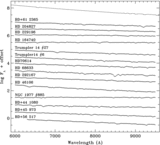An Analysis of the Shapes of Interstellar Extinction Curves. VI. The Near-IR Extinction Law
Abstract
We combine new observations from the Hubble Space Telescope's Advanced Camera of Survey with existing data to investigate the wavelength dependence of near-IR (NIR) extinction. Previous studies suggest a power law form for NIR extinction, with a "universal" value of the exponent, although some recent observations indicate that significant sight line-to-sight line variability may exist. We show that a power-law model for the NIR extinction provides an excellent fit to most extinction curves, but that the value of the power, β, varies significantly from sight line to sight line. Therefore, it seems that a "universal NIR extinction law" is not possible. Instead, we find that as β decreases, R(V) ≡ A(V)/E(B - V) tends to increase, suggesting that NIR extinction curves which have been considered "peculiar" may, in fact, be typical for different R(V) values. We show that the power-law parameters can depend on the wavelength interval used to derive them, with the β increasing as longer wavelengths are included. This result implies that extrapolating power-law fits to determine R(V) is unreliable. To avoid this problem, we adopt a different functional form for NIR extinction. This new form mimics a power law whose exponent increases with wavelength, has only two free parameters, can fit all of our curves over a longer wavelength baseline and to higher precision, and produces R(V) values which are consistent with independent estimates and commonly used methods for estimating R(V). Furthermore, unlike the power-law model, it gives R(V)s that are independent of the wavelength interval used to derive them. It also suggests that the relation R(V) = -1.36 {E(K-V)}/{E(B-V)} - 0.79 can estimate R(V) to ±0.12. Finally, we use model extinction curves to show that our extinction curves are in accord with theoretical expectations, and demonstrate how large samples of observational quantities can provide useful constraints on the grain properties.
- Publication:
-
The Astrophysical Journal
- Pub Date:
- July 2009
- DOI:
- 10.1088/0004-637X/699/2/1209
- arXiv:
- arXiv:0905.0133
- Bibcode:
- 2009ApJ...699.1209F
- Keywords:
-
- dust;
- extinction;
- Astrophysics - Galaxy Astrophysics
- E-Print:
- To appear in the Astrophysical Journal
